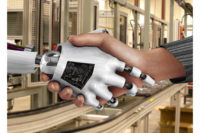Robot Safety Challenges and Opportunities
“Safe Motion” is still a relatively new concept in the robotics industry. Many challenges still need to be addressed before the technology is widely accepted by manufacturing engineers and safety professionals.
ASSEMBLY recently asked a group of experts to share their thoughts on the subject. Participants includedClaude Dinsmoor, general manager of controller product development at FANUC Robotics America Inc. (Rochester Hills, MI);Michael Gerstenberger, senior engineer at KUKA Robotics Corp. (Clinton Township, MI);Jerry Hendrickson, engineering program manger at Adept Technology Inc. (Livermore, CA);Eric Hollister, product sales engineer at Pilz Automation Safety (Canton, MI);Brian McMorris, robotics industry manager at SICK Inc. (Minneapolis); andRobin Schmidt, chief engineer at ABB Robotics Inc. (Auburn Hills, MI).
ASSEMBLY:What safe motion challenges or hurdles still need to be addressed by the robotics industry?
Dinsmoor:Using dual-check safety speed and position check, as well as the safety-rated robot features from any robot manufacturer, requires the robot system integrator and end user to be well aware of U.S. standards that detail the requirements for the safe implementation of a robot system. The key standards are RIA/ANSI R15.06:1999 and the new ANSI/RIA/ISO 10218-1:2007 (which details the requirements for safe motion technology from a robot manufacturer.
Gerstenberger:The main challenge now is getting the word out about these features and the possibilities they offer. Some customers have been concerned about whether robot systems employing this technology would meet current industrial robot safety standards. To address those concerns, the committee responsible for the ANSI/RIA R15.06 industrial robot safety standard has just written a technical report, R15.206, describing how to make use of the new features covered in the new ANSI/RIA/ISO 10218-1 industrial robot safety standard (which covers only the robot itself) in a robot workcell that meets the intent of the R15.06 standard, which covers the entire robot system.
Hendrickson:The challenge will be the robot controls’ ability to sense and react to its environment in a generic sense. Specified conditions and environments can be dealt with to produce safe motion. Unspecified conditions and environments will be a challenge. Changing or altered conditions from that programmed will also be a challenge.
Warning systems are also important to protect humans when motion exists. The ability for people to intervene and stop motion is critical. The robot’s motion needs to stop when safety systems are activated. Other important considerations include external sense of the robot’s environment to allow for collision avoidance and possible path rerouting or robot hold-in-place; sense of the end effector and it’s proximity within the environment; and force detection on the end effector for collision detection.
Sense of environment is not enough to support safe systems. The logic-reasoning needs to be built in to act on the input from the environment. The ability to make decisions quickly is key to safe systems.
Hollister:From a product perspective, the challenge becomes managing the amount of data which is induced in the real time interaction between the external (vision-based) area sensors and the safe motion control systems. Your control system changes from a discrete (on-off) bitwise communication to that of a dynamic interation-reaction between the two devices. This will require standardized communication protocols, as well as control algorithms, to make efficient use of the data.
McMorris:As with most technologies, the biggest hurdle is adoption by management and workers accustomed to a traditional approach to production. Human inertia is an important consideration when it comes to implementing radically different approaches to manufacturing. There may be some concern that freeing up robots from their previously well-defined locations and roles on the plant floor will threaten employment. There will also likely be safety concerns, even if unfounded, by the advances in robot safety design, as the physical barriers between robots and humans are reduced or eliminated.
Schmidt:The biggest challenge is understanding the technology and implementing standards. The pattern of this safety technology is solid and has been in use for a number of years, but the application to motion system with this technology can seem to some like a new technology. It is another application of a proven technology. Primarily, we need to educate systems integrators and end users.
Looking for a reprint of this article?
From high-res PDFs to custom plaques, order your copy today!





